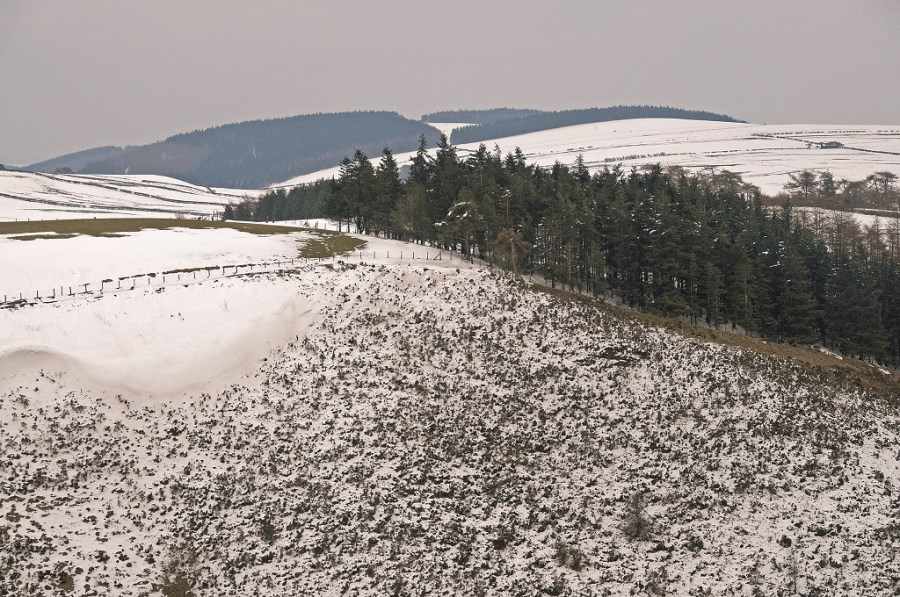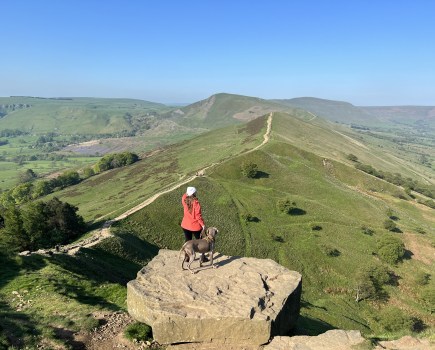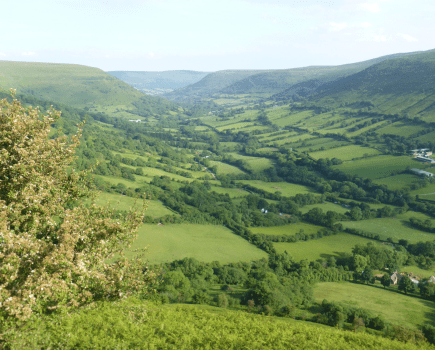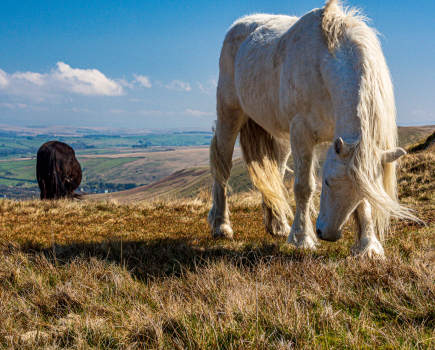Roger Butler ploughs through deep drifts to explore Offa’s Dyke
KING OFFA LEFT behind a memorable landmark when he pushed his earthworks across the lonely hills north of Knighton and we were soon planning a visit once reports described the deep snow that had swept across this classic bit of borderland. I’d wandered up here many times before, but had never experienced the Marches in full winter raiment, and reports of impassable lanes and helicopter drops to isolated farms all pointed to a special day out on the dyke.
A sign by the riverside marked the border and with one foot in England and the other in Wales we looked up at the steep snow-draped hills. Another light dusting fell like dandruff as we crossed the footbridge and headed up the side of Kinsley Wood. The birds were busy and their cheerful chirps helped spur us on. The trees resembled an old fashioned monochrome print with their jet black trunks and feathery grey branches, but the nearby bracken was buried beneath a good foot of snow and leaden skies hinted at the possibility of more serious flurries later in the day.
A carefully-crafted igloo had been built at the top of the escarpment and this icy grotto offered fine views across the first wave of Welsh hills. The rambling plateau of Beacon Hill appeared to be an isolated massif rising proudly above empty undulating moorland. Down in the valley the dark waters of the River Teme meandered through wet meadows like a blunt pencil line, whilst further afield snow picked out the farmer’s tracks that spluttered up distant spurs.
The drifts were quite extraordinary. Field boundaries and gates had disappeared under a tsunami of snow and the only reference to any long distance path was a small waymark, nailed to the top of a post that had somehow remained uncovered. Dips by the dyke and hollows by the hedges were all brim full, but cold winds had created a crunchy topping which made our progress surprisingly straightforward.
The slopes above Garbett Hall, where the badger-riddled dyke is enclosed by some of its deepest ditches, had taken a full pasting but once free from the ever playful lambs we decided to have some frolics of our own. We deliberately floundered through drifts that were at least six feet deep, but when the going eventually became too tough we hauled each other up onto relatively open ground. Here, the wind had helped shape striking snowy sculptures and we awarded an artistic prize to a giant dolphin’s flipper that defied gravity as it arched outwards from the dyke.
An easterly was blowing full pelt as we approached Llanfair Hill and cold fingers made me wonder if my new £50 mitts were really fit for purpose. Distinctive hare tracks were now two a penny and the odd fox had been out in search of frozen morsels. A cluster of ponies shivered as we turned west and dropped down to the mud strewn lane at Bwlch. The paths in the valley seemed just a little dreary after all the fun we’d had up on the dyke.
ROUTE DESCRIPTION
- From Offa’s Dyke Centre follow signs to river and walk W to cross footbridge, railway and lane. Climb N up slopes to crest of escarpment and walk broadly NNW following Offa’s Dyke path.
- After 3km descend steeply from Cwmsanaham Hill to Brynorgan cottage and lane. Turn L, then R, and follow slight path diversion to reach lane by Garbett Hall.
- Continue along Dyke, past isolated barn and plantation, and just before Llanfair Hill take right of way on L leading SW around head of wooded valley. Join track which drops to farm buildings at Bwlch.
- Turn L on narrow lane, after 700m take path on R uphill through woods and continue S over hill and drop to lane at Llanfair Waterdine. Turn L, then R at junction.
- Turn L on B4355 for 200m, turn R up lane. Follow paths and tracks into Knucklas and return to Knighton by bus or train (or walk along lanes back to start).
Roger Butler ploughs through deep drifts to explore Offa’s Dyke
KING OFFA LEFT behind a memorable landmark when he pushed his earthworks across the lonely hills north of Knighton and we were soon planning a visit once reports described the deep snow that had swept across this classic bit of borderland. I’d wandered up here many times before, but had never experienced the Marches in full winter raiment, and reports of impassable lanes and helicopter drops to isolated farms all pointed to a special day out on the dyke.
A sign by the riverside marked the border and with one foot in England and the other in Wales we looked up at the steep snow-draped hills. Another light dusting fell like dandruff as we crossed the footbridge and headed up the side of Kinsley Wood. The birds were busy and their cheerful chirps helped spur us on. The trees resembled an old fashioned monochrome print with their jet black trunks and feathery grey branches, but the nearby bracken was buried beneath a good foot of snow and leaden skies hinted at the possibility of more serious flurries later in the day.
A carefully-crafted igloo had been built at the top of the escarpment and this icy grotto offered fine views across the first wave of Welsh hills. The rambling plateau of Beacon Hill appeared to be an isolated massif rising proudly above empty undulating moorland. Down in the valley the dark waters of the River Teme meandered through wet meadows like a blunt pencil line, whilst further afield snow picked out the farmer’s tracks that spluttered up distant spurs.
The drifts were quite extraordinary. Field boundaries and gates had disappeared under a tsunami of snow and the only reference to any long distance path was a small waymark, nailed to the top of a post that had somehow remained uncovered. Dips by the dyke and hollows by the hedges were all brim full, but cold winds had created a crunchy topping which made our progress surprisingly straightforward.
The slopes above Garbett Hall, where the badger-riddled dyke is enclosed by some of its deepest ditches, had taken a full pasting but once free from the ever playful lambs we decided to have some frolics of our own. We deliberately floundered through drifts that were at least six feet deep, but when the going eventually became too tough we hauled each other up onto relatively open ground. Here, the wind had helped shape striking snowy sculptures and we awarded an artistic prize to a giant dolphin’s flipper that defied gravity as it arched outwards from the dyke.
An easterly was blowing full pelt as we approached Llanfair Hill and cold fingers made me wonder if my new £50 mitts were really fit for purpose. Distinctive hare tracks were now two a penny and the odd fox had been out in search of frozen morsels. A cluster of ponies shivered as we turned west and dropped down to the mud strewn lane at Bwlch. The paths in the valley seemed just a little dreary after all the fun we’d had up on the dyke.
ROUTE DESCRIPTION
- From Offa’s Dyke Centre follow signs to river and walk W to cross footbridge, railway and lane. Climb N up slopes to crest of escarpment and walk broadly NNW following Offa’s Dyke path.
- After 3km descend steeply from Cwmsanaham Hill to Brynorgan cottage and lane. Turn L, then R, and follow slight path diversion to reach lane by Garbett Hall.
- Continue along Dyke, past isolated barn and plantation, and just before Llanfair Hill take right of way on L leading SW around head of wooded valley. Join track which drops to farm buildings at Bwlch.
- Turn L on narrow lane, after 700m take path on R uphill through woods and continue S over hill and drop to lane at Llanfair Waterdine. Turn L, then R at junction.
- Turn L on B4355 for 200m, turn R up lane. Follow paths and tracks into Knucklas and return to Knighton by bus or train (or walk along lanes back to start).








